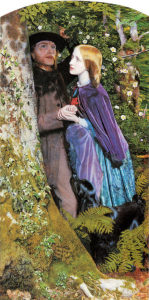The first reference to St Valentine’s Day being for lovers came in Geoffrey Chaucer’s 1382 poem Parlement of Foules, when he wrote “For this was on St Valentine’s Day when every bird cometh there to choose his mate.”

The Long Engagement by Pre-Raphaelite artist Arthur Hughes was given to the Birmingham Museum & Art Gallery in the will of a Dr Griffiths in 1902, and has remained in the collection to the present day.
Originally entitled Orlando, The Long Engagement was created between 1854 and 1859 and depicts a curate and his fiancée in a woodland setting.
The title refers to middle class social conventions of the time, in particular the fact that the parents of a girl engaged to a poorly paid curate would typically not allow the marriage until he had secured a more remunerative position – i.e. within the church hierarchy. The girl is depicted looking at her own name (Amy) carved, some while ago, into the trunk of the tree by her fiancé as an expression of his love. The carving, however, is about to be covered by rambling ivy growing up the trunk; ethereal youthful passion is becoming lost to worldly capitalist demands.
The Victorians popularised the sending of Valentine’s cards – the earliest were flat paper sheets, with printed colour illustrations and embossed borders, but they were too expensive to send. The introduction, by Sir Rowland Hill (born in Kidderminster), of the flat-rate one penny postage in 1840 started the mass production of Valentine’s cards. The following year 400,000 were sent and postmen were given special refreshment breaks to cope with the dangerous extra loads.
